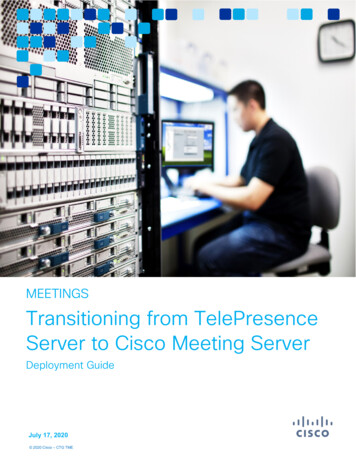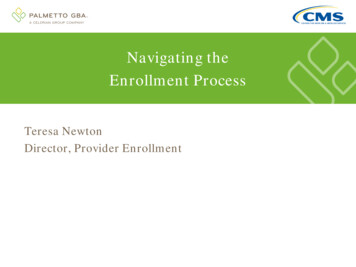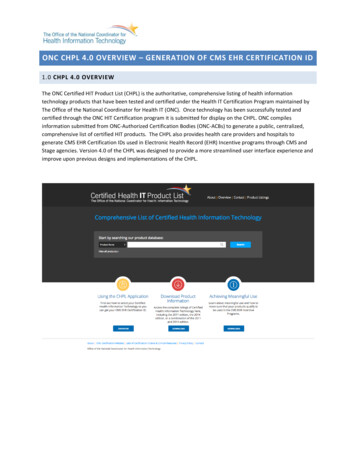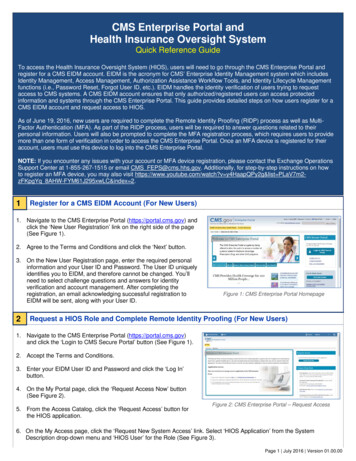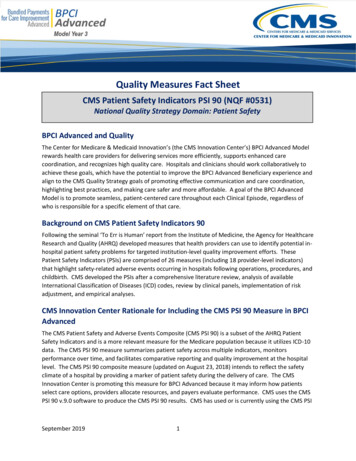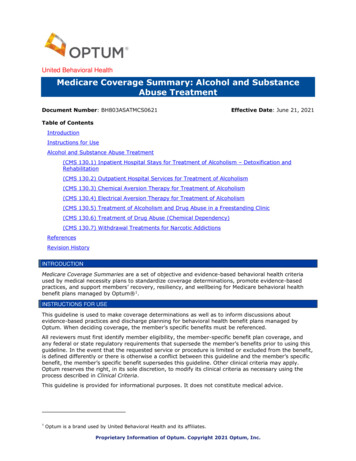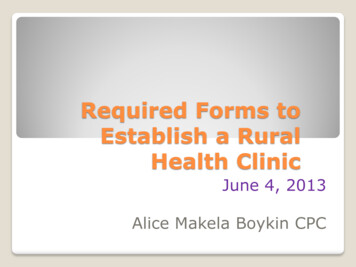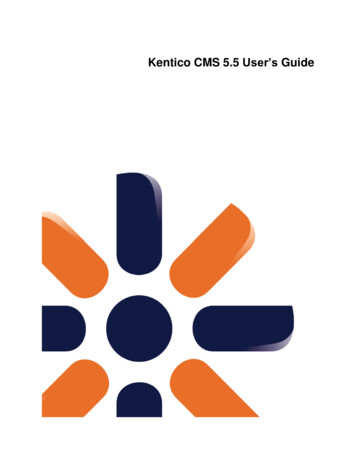
Transcription
CMS and ONC: Enabling Data Interoperability Across theContinuumMarch 19, 2019Presenters:Beth Connor, CMSLorraine Wickiser, CMSElizabeth Palena Hall, ONCMichelle Dougherty, RTIDave Hill, MITRE
Acronyms in this Presentation CMS – Centers for Medicare & Medicaid ServicesCCD – Continuity of Care DocumentC-CDA – HL7 Consolidated Clinical Document ArchitectureCCDS – Common Clinical Data SetDCPAC – Division of Chronic and Post-Acute CareDEL – Data Element LibraryFHIR – Fast Healthcare Interoperability ResourcesHHA – Home Health AgencyHIS – Hospice Item SetHIT – Health Information TechnologyHL7 – Health Level 7IMPACT – Improving Medicare Post-Acute Care Transformation ActIRF – Inpatient Rehabilitation FacilityIRF-PAI – Inpatient Rehabilitation Facility Patient Assessment Instrument2
Acronyms in this Presentation (Cont.) ISA – ONC Interoperability Standards Advisory LCDS – Long-Term Care Hospital (LTCH) Continuity Assessment Record and Evaluation (CARE)Data Set LOINC – Logical Observation Identifiers Names and Codes LTCH – Long-Term Care Hospital MDS – Minimum Data Set OASIS – Outcome and Assessment Information Set ONC – Office of the National Coordinator for Health IT PAC – Post-Acute Care RELMA -- Regenstrief LOINC Mapping Assistant SNF – Skilled Nursing Facility SNOMED-CT – Systematized Nomenclature of Medicine - Clinical Terms SPADEs – Standardized Patient Assessment Data Elements USCDI -- U.S. Core Data for Interoperability VSAC – Value Set Authority Center3
Agenda The patient story: Use cases for health information exchange and care coordinationThe Improving Medicare Post-Acute Care Transformation Act and the DELData interoperability: Benefits and challengesDEL next steps: FHIR 4
Objectives Describe the CMS approach for development and implementation of the CMS Data Element Library. Describe how various users can utilize the CMS DEL functionality including search and reports. Define the goals of standardized CMS assessment content mapped to HIT vocabularies andexchange standards. Discuss the strategies and use cases for how assessment content can be re-used to supportdischarge planning, quality improvement, and reduce burden through interoperable healthinformation exchange. Explore how the emerging FHIR standards can be used to enable exchange among providers andwith patients and their care givers.5
The patient story and value of post-acute care interoperable dataexchange across the continuum6
Why is Post-Acute Care Important?PAC Setting Long-Term Care Hospitals(LTCH) Skilled Nursing Facilities (SNF) Home Health Agencies (HHA) Inpatient Rehabilitation Facilities(IRF) Hospices Approximately 33,000 PACProviders in the U.S.7
Episodes Requiring PAC Services after an Acute HospitalizationMEDICARE BENEFICIARIES REQUIRING PAC SERVICESAFTER AN ACUTE HOSPITALIZATION IN 2014PAC Services45%No Services55%8
The Most Frequent Sequences of ians and specialists also coordinateon-going care with PAC default-source/contractor-reports/sept2018 pac sequence of care w cov contractor sec.pdf?sfvrsn 09
Volume of Claims by Chronic Conditions in 2016Source: 2016 Medicare Claims Data10
Distribution of Beneficiaries by Number of Chronic Conditions &Total Medicare Spending in 2015Source: onic-conditions-state/cc state dashboard.html11
The Patient Story12
Points of Failure Poor communication across care providers, including outpatient Medication discrepancies such as drug omissions during transitions of care are common Multiple modes of information transmission are often used Delays in PAC services can lead to adverse events and preventable readmissions Redundant information collection creates inefficiencies and burden Reliance on patient recall during periods of high stress Recall of information can be unreliable Increased patient / family stress Increased Cost and Provider Burden Additional costs related to hospital stays from adverse events, readmissions Additional administrative costs to locate, reconcile and coordinate information Longer length of stays and higher resource utilization13
ONC Data Brief: SNF & HHA EHR Adoption and Interoperability in2017 EHR adoption rates were higher among HHAs compared to SNFs in 2017HHASNFNo EHR22%No EHR34%EHR66%EHR78%* HHAs are more likely than SNFs to engage in each domain of ndReceive36%*18%Source: 48%Outside InfoAvailable14
Interoperability Challenges Lack of business case Lack of standards or consistent use of standards Limited understanding of interoperability and its value Lack of formalized workflows Frequent changes to payment models diverts resources from investment in interoperability Meeting CMS regulatory requirements diverts resources from investment in interoperability Lack of data transparency Data exchange between EHR systems is poor Staff recruiting and retention in PAC facilities15
Interoperability Challenges (Continued) Accessibility is problematic for some patients Working physicians are not involved enough in standardsdevelopment and software design Senior housing facilities do not employ any health IT infrastructure Assisted living facilities have been slow to adopt EHRs Post-acute utilization is high and increasing Internet connectivity for some health facilities is poor Patient matching is difficult, inaccurate, and hard to automate Data provided by ambulatory care are not timely16
Potential Cost Savings related to Points of Failures Description and Financial Costo Time PCP spends collecting information, faxing and re-faxing or sendinginformation through another mode (1 hour of time): 107*o Average cost of adverse event during a hospital stay: 13,745 #o Average cost of a Home Health Agency Stay: 3,040 †o Average cost of an Inpatient Rehabilitation Facility Stay: #19,714 †o Average cost of a Skilled Nursing Facility stay: 18,174 †o Average cost of a Long-Term Care Hospital stay: 40,656 †* on-overview-6009667#2# L Levinson DR. Washington, DC: US Department of Health and Human Services, Office of the Inspector General;November 2010. Report No. OEI-06-09-00090† MedPAC, A Data Book: Health care spending and the Medicare program, June 201817
IMPACT Act and CMS Data Element Library18
IMPACT Act of 2014 Bi-partisan bill passed on September 18, 2014, and signed into law October 6, 2014 The Act requires standardized patient assessment data elements for: Long-term Care Hospitals (LTCHs) Skilled Nursing Facilities (SNFs) Home Health Agencies (HHAs) Inpatient Rehabilitation Facilities (IRFs) The Act specifies that data “ be standardized and interoperable so as to allow for the exchange ofsuch data among such post-acute care providers and other providers and the use by such providersof such data that has been so exchanged, including by using common standards and definitions inorder to provide access to longitudinal information for such providers to facilitate coordinated careand improved Medicare beneficiary outcomes ”.Improving Medicare Post-Acute Care Transformation (IMPACT) Act of 201419
Data Element Interoperability IMPACT Act requires that post-acute care assessment data elements be interoperable to: “allow for the exchange of data among PAC providers and other providers and the use by such providers of such datathat has been exchanged, including by using common standards and definitions, in order to provide access tolongitudinal information for such providers to facilitate coordinated care and improved Medicare beneficiaryoutcomes.” Interoperable data elements facilitate improvements to reduce overall provider burden by allowingthe use and reuse of healthcare data Supports provider exchange of electronic health information to facilitate care coordination andperson-centered care Supports real-time, data driven, clinical decision making20
IMPACT Act Requirements Data Must be Interoperable Quality Measures–––––– Standardized DataSubmissionFunctional StatusSkin IntegrityMedication ReconciliationIncidence of Major FallsTransfer of Health InformationMedicare Spending perBeneficiary– Discharge to Community– Potentially PreventableHospital Readmissions– Admission and Discharge– Functional status– Cognitive function and mentalstatus– Special services, treatments, andinterventions– Medical conditions and comorbidities– Impairments– Other categories required by theSecretary21
What are Post-Acute Care Assessments?OASIS C2 CMS PACAssessments: LTCH ContinuityAssessment Record &Evaluation (CARE) DataSet (LCDS) Resident AssessmentInstrument (RAI)Minimum Data Set(MDS) Outcome andAssessment InformationSet (OASIS) IRF Patient AssessmentInstrument (IRFPAI) Hospice Item Set (HIS)*22
PAC Assessment Content Administrative Content–––––––– Patient NameDate of BirthRace/EthnicityMarital statusAdmission/Discharge datesAdmit from/Discharged to locationsReason for admissionProvider NPI, CCN, Medicaid Provider #Standardized Patient Assessment DataElements (SPADEs) across instruments––––––Function (e.g., self care and mobility)Cognitive function (e.g., express & understand ideas; mentalstatus, such as depression and dementia)Special services, treatments & interventions (e.g., need forventilator, dialysis, chemotherapy, and total parenteralnutrition)Medical conditions and co-morbidities (e.g., diabetes, heartfailure, and pressure ulcers)Impairments (e.g., incontinence; impaired ability to hear, see,or swallow)Other categories Clinical ��–––Diagnosis/medical conditionsMental/Cognitive Status (memory, orientation, consciousness,delirium, mood, behavior)Communication (express needs, understanding verbal/nonverbal content, hearing and vision)Functional Status (Self-care/ADLs, Mobility, Use of assistivedevices)Bladder and Bowel continenceFallsPressure ulcers and other skin conditionsSurgeryNutritional and swallowing statusMedication informationSpecial treatments, procedures & programsHeight and WeightPatient preferences and goals of treatmentPainVaccinationsTherapy- PT, OT, SLTLiving arrangements/support availabilityCare planning23
SPADES: Standardized Assessment: Many UsesData Elements: Question and ResponseQualityReportingQICare Planning/Decision SupportCareTransitionsPayment24
The Data Element Library (DEL) The DEL is a centralized resource for CMS assessment data elements(e.g. questions and response options), and their related mappings tonationally accepted health IT standards PAC Settings and Their CMS Assessments:o Long-term Care Hospitals (LTCHs) LTCH ContinuityAssessment Record & Evaluation (CARE) Data Set(LCDS)o Skilled Nursing Facilities (SNFs) ResidentAssessment Instrument (RAI) Minimum Data Set(MDS)o Home Health Agencies (HHAs) Outcome andAssessment Information Set (OASIS)o Inpatient Rehabilitation Facilities (IRFs) IRF patientassessment instrument (IRF-PAI)o Hospices Hospice Item Set DEL ContentsAssessment and version (e.g., MDS 3.0 v.1.16)Item label (e.g.- GG0170)Item status (Published, Active, Inactive)Copyright information (if applicable)CMS usage (Payment, Quality Measure,Survey and Certification, etc.)Identification of skip pattern triggers andlookback periodsHealth IT standards (e.g., LOINC, SNOMED)Visit the DEL here: https://del.cms.gov25
DEL Homepage Overview Announcements ListservVisit the DEL here:https://del.cms.gov26
Search Categories27
Search Results List28
Detailed Data Element Information29
OASIS D Health IT Codes30
Training/FAQs31
Alignment and Interoperability: Advancing interoperability byaligning assessment content with industry standards and mappingcontent to vocabularies, terminologies and code sets32
Guiding Principle: Data Needs to Follow the PersonSupport data availability in real-time. Electronic information is exchangedand used by health IT systems without special effort on the part of the user.33
Making PAC Assessment Data Elements Standardized/Aligned andInteroperableRelevant interoperableassessment data (suchas functional status,cognitive status, etc.)can be used to populatedocuments34
CMS Data Element Library HIT Workgroup FocusVision for InteroperableAssessment ContentOpportunities for BurdenReductionAligning with NationalStandardsMapping to RelevantVocabulary & TerminologyStandardsUse Cases forInteroperable AssessmentContentUse of InteroperableAssessment Content byImplementers35
Vision for Interoperable Assessment Content Strategy: Leverage standardized data that is collected on almost allPAC patients to advance interoperability, reduce burden, andimprove patient care. Models: Identify single code to represent the assessment question andresponse and re-use data in relevant exchange documents(current focus) Identify a value set of codes that could be used to supportcompletion of an assessment item (future)36
Opportunities for Burden Reduction and Improved Communication Real-time data availability improves patient care Machine processable data reduces provider burden: Eliminates duplicative data entry Minimizes searching medical record for relevant content Experiences of Early Adopters - Faster Data Entry Valuable to have common data standards across providertypes Data from exchange documents (e.g. CCD) populates thepatient record37
Use Cases for Interoperable Assessment Content Care coordination betweenmultiple providers / proxy / familymembers Appointments, readmissions, sharingcare plan, chart sharing, transportation Transitions of care referrals Intake, info queries, transition out,follow-up activity coordination Medication reconciliation Clinical decision support Admission / Dischargeinformation notifications Helps all parties to track patient status Population Health ManagementAdministration Quality management, at risk dollars,who is high risk and why Changing relationship betweenpatient and caregivers Connective devices, patientengagement, monitoring, telehealth Getting providers engaged Quality compared to peers, financialmetrics, cost of care Advanced directives Sharing and notifications38
Aligning With National Standards ONC Interoperability Standards Advisory DEL Health IT standards align with national policy LOINC and SNOMED-CT for assessment content Analyzed Common Clinical Data Set/U.S. Core Data for Interoperability(USCDI) Identified opportunities for alignment of assessment content to USCDI Provided comments on future candidate data types important to supportPAC for USCDI expansion 2019 ONC Interoperability Standards Advisory: efiles/2019ISAReferenceEdition.pdfONC Common Clinical Data Set: ility-basicstraining/lsn1069/010110---a.htmDraft USCDI: -uscdi.pdf39
Mapping to Relevant Vocabulary & Terminology Standards Selected codes aligned with national policy andutilized in exchange standards (e.g. C-CDA templates) Mapped assessment content to LOINC and SNOMED LOINC codes represent the question and answer SNOMED codes represent the answer meaning LOINC codes are available for PAC assessments on the DELGG0100 as Shown on IRF-PAI40
Use of Interoperable Assessment Content by Implementers Best practices for data element design to support interoperability Ensure health IT content vocabularies Use in HIE standards Leverage DEL’s content with other industry tools such as: Value Set Authority Center (VSAC) Regenstrief LOINC Mapping Assistant (RELMA) Convene Advisory Group (industry and HHS) Input on future direction for DEL and health IT priorities Identify priority use cases that leverage existing standards and address gaps.Tailor implementation guides and coordinate testing.41
Industry Expert Roundtable on CMS Data Element Library Provided feedbackon the CMS DataElement Library:– Inform healthcarepolicies Advance– interoperability– Support transferof care,coordination ofcare, qualitymeasurement,and researchSuggested clarifying scope of DEL and how itshould be used by stakeholders; Ideas for futuredevelopment.Identified priority use cases for transfersummary and care planning; Suggested waysthe DEL to support outreach & testing.Become a resource to connect industry standards– align with other tools, identify/point to relevantstandards, fill gaps.42
Health Data Exchange Through FHIR43
We’re Building the Future with FHIR1)2)3)4)5)6)7)8)Participate in HL7 Working GroupsCreate sustainable PAC Interoperability Working GroupIdentify tightly-scoped use case to implement for a connect-a-thonDevelop FHIR Implementation Guides for use case data modelsReview and harmonize FHIR Implementation Guides with key stakeholdersHost connect-a-thon to test FHIR Implementation GuidesBuild industry consensus around FHIR Implementation GuidesIdentify next agile part of use case to implement, and repeat steps 4 through 8.44
Outpatient EMS Inpatient Home Health45
EMS Inpatient SNF46
Proposed Timeline for FHIR Work (Publish Dec 2019)30 Jun, 2019NOTICE OF INTENT TOBALLOT - DEADLINELANDSCAPE ANALYSISDec 2018Nov 2019RECONCILIATIONSep 20192019 WGM ANDCONNECTATHONIN ATLANTAMar 2019PROJECT SCOPE STATEMENT28 Nov, 2018TAGNov 2018Jul 2019BALLOT CONTENTDec 2019PUBLISH FHIRIMPLEMENTATIONGUIDEGENERATE FHIR PROFILESJan 2019Feb 2019Mar 2019Apr 2019May 2019Jun 2019Jul 2019Aug 2019Sep 2019Oct 2019Nov 20191 October 2018Dec 2019Jan 2020Feb 2020Mar 202031 March 2020Oct 2019NEW FISCAL YEAR47
Call to Action: How to Participate Health IT developers Build on existing health ITsystems Try out newprojects/systems PAC providers Analyze how and whereassessment data fits inclinical workflow Provide feedback ondevelopment priorities Ways to contribute: Subject matter expertise Scalability ofimplementing theeventual solution Assist in the delivery ofkey deliverables andproject artifacts Development of testingtools, testingimplementations, etc.To participate in PAC Interoperability workgroup and FHIRconnect-a-thon contact: Dave Hill, dwhill@mitre.org49
Wrap Up and Question & Answer Session50
Resources For more information on the IMPACT Act, visit the IMPACT Act webpage For more information on Post-Acute Care Quality Reporting Programs, visit: Home Health Agencies Hospice Agencies Inpatient Rehab Facilities Long-term Care Hospitals Skilled Nursing Facilities For DEL updates, sign up for the listserv here For DEL feedback or questions, contact: DELHelp@cms.hhs.gov51
Thank You Beth Connor, CMS Beth.Connor@cms.hhs.gov Lorraine Wickiser Lorraine.Wickiser@cms.hhs.gov Elizabeth Palena Hall, ONC Elizabeth.PalenaHall@hhs.gov Michelle Dougherty, RTI International MDougherty@rti.orgCMS Contractorssupporting the DEL:NIC/TelligenRTI InternationalMITRE Dave Hill, MITRE Dwhill@mitre.org52
Thank You – Please Evaluate Your ExperienceShare your thoughts to help us improve – Evaluate today’s eventVisit: MLN Events webpage for more information on our conference call and webcast presentations Medicare Learning Network homepage for other free educational materials for health careprofessionalsThe Medicare Learning Network and MLN Connects are registeredtrademarks of the U.S. Department of Health and Human Services (HHS).53
DisclaimerThis presentation was current at the time it was published or uploaded onto the web. Medicare policychanges frequently so links to the source documents have been provided within the document for yourreference.This presentation was prepared as a service to the public and is not intended to grant rights or imposeobligations. This presentation may contain references or links to statutes, regulations, or other policymaterials. The information provided is only intended to be a general summary. It is not intended to takethe place of either the written law or regulations. We encourage readers to review the specific statutes,regulations, and other interpretive materials for a full and accurate statement of their contents.54
CCD - Continuity of Care Document CL7 Consolidated Clinical Document Architecture-CDA - H CCDS - Common Clinical Data Set DCPAC - Division of Chronic and Post -Acute Care DEL - Data Element Library FHIR - Fast Healthcare Interoperability Resources
